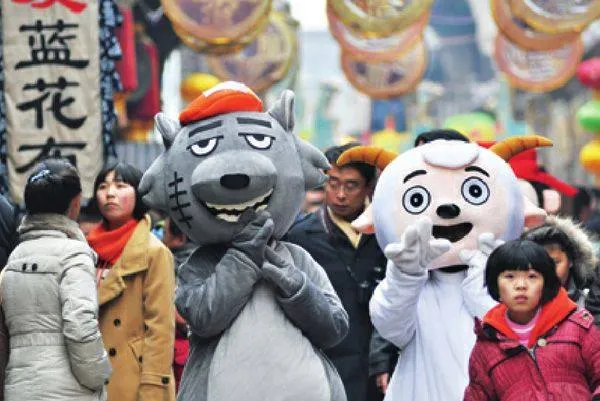Drawing the Line
‘My son watches Black Cat Detective, a cartoon I loved when I was a kid,”said Liu Yang, mother of a six-yearold boy in Beijing. “It is a classic, but too old. What’s wrong with producers? Why can’t there be more new animations for children?”
The cartoon is a Chinese television series produced by the Shanghai Animation Film Studio, and originally aired from 1984 to 1987.
Liu’s worry is a common concern among young Chinese parents.

Unhealthy elements
In addition to the severe shortage of new cartoons, the content of existing programs has raised eyebrows.
On April 10, three boys aged below 10 imitated a scene from Pleasant Goat and Big Big Wolf while playing around. One boy tied the oth- ers to a tree with ropes, then lighted the weeds surrounding their feet.
The incident, which occurred in Lianyungang of east China’s Jiangsu Province, shocked the nation and drew widespread public attention to the violent elements in cartoons.
The injured turned out to be brothers. The elder one, aged 8, suffered severe burns to 40 percent of his body, while the younger one, aged 5, suffered burns to 80 percent of his body, as well as to his respiratory tract.
Subsequent operations cost the family more than 1 million yuan ($164,100) in medical expenses. “If we didn’t receive so much financial help from other people, both kids would not have survived,” said the father Li Kang.
Besides assisting the family with follow-up treatment fees and disability compensation, legal departments also helped them contact the city’s Red Cross Society and Municipal Bureau of Civil Affairs, to obtain more aid.
Pleasant Goat and Big Big Wolf has been extremely popular among kids across the country. It tells the humorous tale of a miserable wolf who tries his very best to catch a clever sheep that always manages to slip away.
Produced by Guangzhou-based Creative Power Entertaining, the show is one of the most successful domestic-made cartoons in China. Since it was aired in June 2005, ratings have soared by 17.3 percent, leaving imported cartoons far behind. It also swept across southeast Asia.
Popular with almost every kid in China, images of the cartoon can be found on items such as clothes, stationery and toys.
Boonie Bears, produced by Shenzhen Huaqiang Digital Animation Co., has also fueled criticism due to its use of vulgar language.
Boonie Bears tells the funny story of fights between two brother bears who protect the forest against a cunning bald woodcutter named Guangtouqiang.
“My son always imitates the weird accent of the younger bear,” said Pang Ning, mother of a 4-year-old in Shanghai.
Another parent stated that 21 vulgar words were once used within 10 minutes during screening, while a child reportedly carried a toy chainsaw with him to kindergarten everyday in imitation of the sly woodcutter.
“My nephew loves watching Boonie Bears, and has almost turned into a bear himself. He often shouts to other kids and even beats them, giving his teacher a real headache,” said Liu Weili, a middle school instructor in Beijing.
The cartoon has been criticized for portraying questionable acts that include wood cutting, hunting, fighting and gun abuse, as well as for its use of words centered on insults and the abuse of animals.
Good news
Fierce criticism has forced improvements to cartoons.
“We should try to prevent every kid from imitating cartoons,” said Yu Shengjun, a cartoon film director, adding that producers were at fault in terms of the Lianyungang tragedy.
Shenzhen Huaqiang Digital Animation Co. has also stated that it is willing to adjust Boonie Bears, changing the term “smelly black bear”to “little bear” for instance, alongside plot lines whereby houses are entered without their owners present.
The government has also strengthened efforts in this regard. The State General Administration of Press, Publication, Radio, Film and Television said that 20 cartoon production companies and broadcast institutions have vowed not to create cartoons containing violent or vulgar content, dangerous plots or foul language.
Besides, it will issue a set of standards related to the content of domestic TV animations by the end of 2013.
In spite of the previously mentioned controversies, creative and culturally rich cartoons are also on the rise in China.
For example, Lanting Elves, produced by Telizhou Animation Co. Ltd. in Shaoxing of east China’s Zhejiang Province, interprets traditional Chinese characteristics as well as calligraphy.
The 52-episode animation was completed after two years’ work, with an investment of 15 million yuan ($2.46 million).
“Are Chinese characters difficult to learn? After watching our cartoon, you will find it both easy and fun,” said company president Ding Liqing.
The cartoon tells the tale of seven elves, who represent the seven basic strokes of the Chinese character. Through humorous stories, it enables the audience to learn the correct writing of Chinese characters in a fun way.
It cleverly incorporates Chinese ink and wash painting into its framework, alongside local Shaoxing elements such as Kuaiji Mountain.
Nowadays, people use computers to write or communicate, which means they often forget how to use the pen. Lanting Elves has done much to redress this issue, said Zhou Yinong, a professor with the University of Shaoxing.
So far, the cartoon, which is especially made for Chinese children and Chinese language learners across the world, has gained global attention. TV stations in the United States, Russia and Switzerland have contacted the company with regards to overseas broadcasting rights. In October, the animation featured at Cannes TV Festival in France, receiving a flood of approval.
Ding is a good example of Chinese cartoon producers dedicated to providing creative ideas for children.
“We are determined to produce excellent animations with rich Chinese cultural elements for kids, free of any violent content,” Ding said.
Born in Shaoxing, China’s textile powerhouse, Ding ran a profitable clothes factory until 2006, when he established Telizhou Animation and shifted his focus to the cartoon industry.
“In 2006, many friends told me it was unwise to give up the factory and charge into the animation industry, with which I was unfamiliar,” Ding explained. “I believe I made the right choice.”
“China is short of creative cartoons for children, which directly affects their growth and so, the future of our country. It adds to culture, while providing both entertainment and ideology.”
Ding’s vision has proven correct. After four years of hard efforts, Shao Nian Shi Ye (Young Expert in Legal Briefs, was aired on the CCTV Children’s Channel and later rewarded as homemade animation of the year by then the State Administration of Radio, Film and Television. It was subsequently aired on most of China’s major local satellite television stations.
The cartoon covers the life of a young, brave and chivalrous Shaoxing expert in legal affairs who, together with his young pals, supports virtue and punishes vice through wisdom.
The audience can also appreciate distinctive local scenery, including bridges, rivers and the black-awning boats of the water town, alongside local cuisine such as stinky tofu.
“I will continue to produce more creative cartoons for children in the future, with culture always the dominant element,” Ding said.

